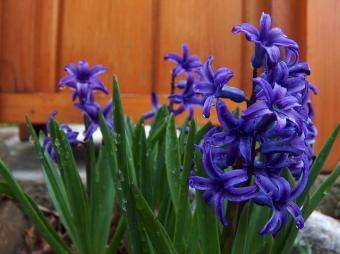
Hyacinthus orientalis
Common name: Dutch or Garden Hyacinth
About Hyacinth
Hyacinthus orientalis is the cultivated species of the genus Hyacinthus. There are only three species in the genus. They are all bulbs that were once placed in the genus Liliaceae but have been moved to their own genus in the family Hyacinthaceae. Dutch hyacinth is native from the eastern Mediterranean region eastward to Iran and Turkmenistan.
The plant is named after a character in Greek mythology, Hyakinthos, a handsome young man who was loved by the sun god Apollo. One day when they were throwing the discus, the jealous god of the West Wind blew the discus back toward Hyakinthos and fatally wounded him. A beautiful flower sprang up where his blood fell on the ground, and Apollo named it after him.
In Western literature, hyacinths are often associated with rebirth.
Hyacinthus orientalis was brought to western Europe in the sixteenth century, when it was cultivated in Austria. During the seventeenth and eighteenth centuries, the hyacinth, like the tulip, was found only in the gardens of the rich. By the end of the eighteenth century, over 2000 cultivars were grown in the Netherlands.
Many plants, especially those like squill, muscari, or brodiea that have flower clusters along a stalk, have common names with the word hyacinth in them. None of them, however, are closely related to Hyacinthus orientalis
Description
Hyacinth is a bulb two to three inches in diameter. The flower stalk is usually about seven inches long and closely packed with single or double flowers, each about an inch long. There are often one hundred flowers on the flower spike. Cultivars have been developed that bloom in a wide range of colors. The leaves are bright green, lance-shaped, and may grow up to fourteen inches long. Hyacinths are intensely fragrant.
Scientific Classification
Kingdom - Plantae
Division - Magnoliophyta
Class - Liliopsida
Order - Asparagales
Family - Hyacinthaceae
Genus - Hyacinthus
Species - Hyacinthus litwinowii, Hyacinthus orientalis, and Hyacinthus transcaspicus
Cultivation
Hyacinths do best in full sun, although they also grow in shade. Any moderately fertile soil with good drainage is fine.
Plant bulbs in the autumn, about a month before the ground freezes so that roots have a chance to develop. Bulbs should be planted more than three inches apart and four to six inches deep. Sprinkle a little bulb fertilizer in the hole. See Planting Bulbs for more information. Hyacinths require a cold dormant period in order to bloom.
Spread fertilizer on top of the soil in spring and scratch in lightly. After the plant has bloomed, cut off the flower spike but leave the leaves. The bulb will store energy for next year's bloom until the leaves wither and die back.
Hyacinth are also grown as potted plants and can be forced to bloom in the winter. See Forcing Bulbs for more information. Hyacinths were traditionally forced in a specially shaped hyacinth vase designed to hold the bulb securely.
Uses
Hyacinths are valued for their color and fragrance in the spring garden. They can also be grown as container plants. They are a popular choice to be forced for winter bloom.
Hyacinths have been grown for use in making perfumes for several centuries.
Varieties to Grow
Hyacinthus orientalis 'Carnegie' - white
Hyacinthus orientalis 'Anna Marie' - salmon pink
Hyacinthus orientalis 'Splendid Cornelia' - pale pink
Hyacinthus orientalis 'Delft Blue' - pale blue
Hyacinthus orientalis `Pink Pearl' - pink
Hyacinthus orientalis `Edelveiss' - white
Hyacinthus orientalis `City of Harlem' - yellow
Problems
Hyacinth can be irritating to the skin and gastrointestinal tract.







